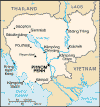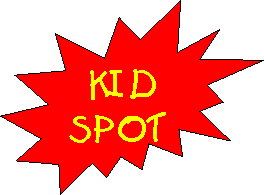
Geography + Government and Economy + History
(For food, language and culture/religion, click on the links to the right)
Geography
Cambodia lies in SE Asia between Thailand, Laos and Vietnam. For more detailed maps of the country and its capital, Phnom Penh, click here. It spans 181,400 sq km (three-quarters the size of the UK) and has a population of 12.7 million (one-fifth that of the UK). 85% of the population lives in rural areas and 40% of the population are under 15 years old.
Cambodia has a tropical climate - basically ranging from hot to boiling (averages of 21-35ºC/70-95ºF with highs of 40ºC/105ºF in April). There are rains from May to October and it is slightly cooler from November to January. About 4/5ths of the annual rainfall comes during the rainy season.
Government and Economy
Cambodia is a constitutional monarchy and democracy - like the UK, but then again not so like it! The Government is a coalition of the Cambodian People's Party led by Prime Minister Hun Sen and FUNCINPEC, the royalist party. The Cambodian People's Party has been in the ascendant since the liberation of the country from the Khmer Rouge. We now have a new king, Norodom Sihamoni, a modest bachelor and lover of classical music and dance. (He used to be a ballet dancer). The old king, Norodom Sihanouk, remains in the background.
Cambodia is one of the poorest countries in the world. Agriculture comprises 80% of the economy. Cambodia's chief exports are natural resources (timber, rubber, rice, corn, rubies) and textiles. OMF works among the garment "factory girls": the stream of workers and clumps of jobseekers outside the factory gates are reminiscent of the Industrial Revolution. Tourism is Cambodia's fastest growing industry (so come and visit us).
For information on Health and Education see Ledgerwood and the CIA factbook. At least half of OMF's team is engaged in development work, much of it focussed on improving health and education provision.
History
|
|
"If something is no use, its disposal is no loss" Khmer proverb (appropriated by the Khmer Rouge to justify mass culling of the weak, old and educated). |
From 8th to 15th centuries, the Khmer built up an empire which stretched over much of SE Asia. This era is deeply significant to Cambodians even today (no other country puts a temple on its flag to remind itself of its past grandeur). After a period of decline, squeezed by Thailand, Vietnam and colonial powers, Cambodia was drawn into the Vietnam war. The US carpet-bombed the area in an attempt to wipe out Viet-cong cross-border bases. In 1970 King Sihanouk was ousted but in 1975 Lon Nol's US-backed government fell to the Khmer Rouge - ultra-Marxist guerillas. The Khmer Rouge turned the country into a vast labour camp. Around 2 million people died during this time (roughly one-quarter of the population at the time), so no-one remained untouched by the suffering.
The Khmer Rouge's hold on government was ended by the Vietnamese in 1979 - but the fighting continued and real peace didn't come until the 1990s. Millions of landmines remain, the country is still operating at only 40-50% of its pre-war capacity, and the emotional scars run very deep.
For more info, see this timeline.
Red/black location map adapted from Graphic Maps
Sources for this page and sub-pages: BBC; CIA factbook; Lonely Planet; OMF



